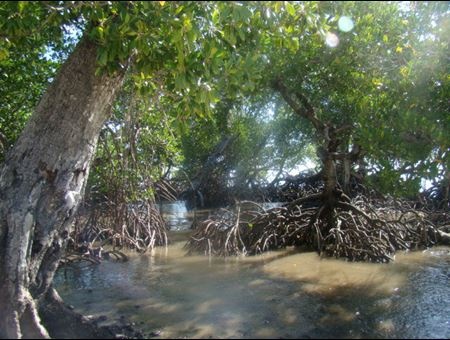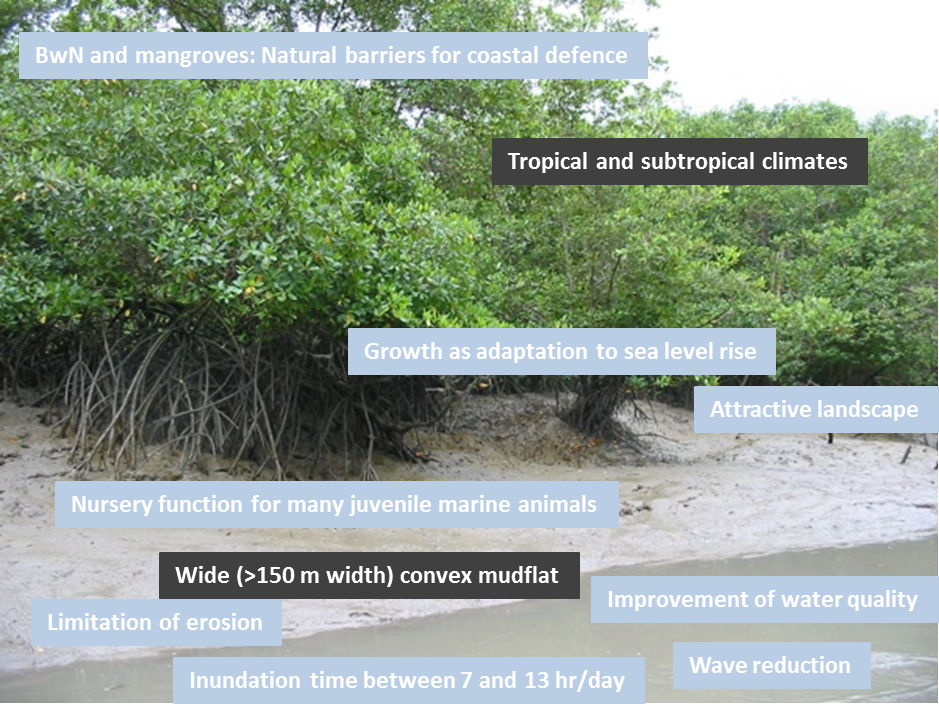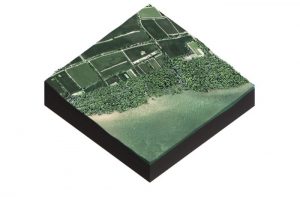Get Started
This Concept focuses on the creation of tropical mangrove forests that dissipate wave energy in the intertidal zone and influence erosion and sedimentation. The development of a mangrove-based design requires integration of ecological and engineering knowledge. A first assessment can be made with limited site-specific knowledge, for instance making use of local and historical data. Subsequently, for each new case a detailed feasibility assessment has to be made, integrating generic and site-specific ecological and engineering knowledge with socio-economic aspects.
This Concept describes the habitat requirements for mangrove forests in muddy environments with a high sediment input. This guideline can be used to check whether a certain location is suitable or can be made suitable for the establishment of mangrove forests.
Required skills
With this manual, anyone having a basic level of knowledge and/or working experience in tropical or subtropical coastal systems can make a first-order assessment. To fully assess the suitability for mangrove forests one should have additional ecological expertise on mangroves.

BwN Interest
The added value of this Concept to Building with Nature (BwN) type projects is that it enables creating natural coastal barriers with forest-forming ecosystem engineers. Ecosystem engineers are certain key species that form structurally complex habitats. The implementation in BwN projects aims to combine the intended primary function, e.g., coastal protection and/or associated economic and social returns, with biodiversity enhancing habitat restoration/conservation.

Advantages
- Decreases shore erosion by dissipating wave-energy
- Provides shelter for other species. Has a nursery function for juvenile marine animals. These animals are sometimes commercially interesting.
- Carbon sequestration
- Providing wood and charcoal
- Water quality improvement
- Sustainable barrier which grows with (relative) sea level rise by trapping sediments
Disadvantages
- Mangroves only occur in tropical and subtropical environments
- The inundation time must be between 7 and 13 hours a day
- Needs space, a width of at least 150 m is necessary
- Present (eco)system can be degraded
- Maturation in protection function takes time. In Singapore it took 6 years after natural seedling before a mature mangrove forest was established (Lee et al., 1996). In the early stages of the mangrove forest it is sensitive and can only withstand low stress levels.
Habitat requirements mangroves
This Concept is developed for tropical mangrove coasts with relatively high sediment input, preferably clays and silts. For mangrove forests with a peaty substrate (> 30% organic material) ecosystem functions, accretion processes and relative sea-level rise impacts may differ and are not described herein. In addition, latitudinal limits (i.e. temperature zones) are not considered.

This Concept describes the habitat requirements for tropical mangrove forests based on the 4 spheres approach, because all these four spheres (Biosphere, Hydrosphere, Lithosphere and Atmosphere) interact with each other and cannot be evaluated on their own. The biosphere includes all living organisms, the hydrosphere relates to water in or near the earth, the lithosphere represents the solid materials, soils and rocks, and the atmosphere relates to weather and climate. For each of these spheres the relevant parameters are described, including the ranges within which the ecosystem can be established. These values are derived from literature. Based on these ranges one can estimate if a specific location can be made suitable for mangroves and under which conditions. A complete overview of the four spheres and the relevant parameters are shown in the flowchart in the How to Use section.
For more detailed information on the spheres, given in the image above, click the links below.

